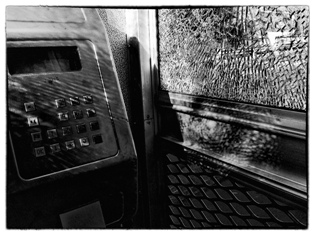
A phone box with shattered glass is a rare sight in this sleepy town, fortunately. It does make for interesting patterns though.


A phone box with shattered glass is a rare sight in this sleepy town, fortunately. It does make for interesting patterns though.
It’s been a place of mystery since early childhood when I was told never to go near it. Especially with a knife. Today I went near it and looked inside. This is what I saw.
So that’s what holds the bread in the toaster. There you go. While I didn’t have a knife, I did have my camera with my current favourite lens thrown open to f1.2.

What you get when first attempting the 'reverse lens' technique to get closer to the subject. Jane McLoughlin©
This morning I took myself off to a little workshop on close-up & macro photography. The workshop was run by ABC Open as part of their Up Close photography project. Now, I already have entered the competition (see my entry here. Feel free to comment, I can handle criticism!). But I quite like the idea of looking closely at the world around me and taking a look at small details that by themselves, tell a story. So while I wistfully gaze at the macro lens on display at the local camera shop and saving my pennies, I make do with the lenses I have at my disposal. But I know there’s so much more to learn, so I jumped at the opportunity to attend the workshop.
The workshop touched on a range of subject matter. Developing one’s ‘photographer’s eye’, composition, depth of field and focal point were all discussed. The most interesting discussion was the inexpensive and relatively easy-to-use gear to allow the camera to get closer to the action. The first was the use of extension tubes to allow a standard lens to mimic a macro lens. Unfortunately there were no extension tubes at the workshop for me to have a play with. That may have to wait for another day, if I can lay my hands on an inexpensive one.
What was available at the workshop was a magnifying glass and a loupe to place in front of the lens to give greater magnification. The loupe, in particular, produced spectacular results when workshop participants placed it in front of a compact digital camera lens. I also had fun using it over the camera in my mobile phone. It was too small for the SLR lens unfortunately. The ‘reverse lens’ technique was also discussed at the workshop. An old Pentax 35-70mm zoom was looking lonely and forlorn on the table so I grabbed it for a ‘rough and ready’ attempt of reversing the lens. The result was the shot seen up top (the ‘telescope’ look at a flower style). Clearly I have a way to go to getting a handle on this technique! If nothing else, I like the colours.
The workshop finished up with a 15 minute shoot outside the building with the idea of capturing images ‘close up’. The loupe, magnifying glass, etc. were utilized by others so I concentrated on ‘close up’ rather than ‘macro’.
I’m still coming to grips with HDR photography. The jury’s out. I don’t know if I like it or not. The surreal, hyper-colours of a lot of HDR photography doesn’t do much for me. My preference is for subtlety, uncertaintly as to whether I am actually viewing a HDR image or not.
However, I do find myself responding in a positive fashion to a lot of black and white HDR that I see on Flickr. There’s something about seeing the tonal range without the distraction of colour to mask it.
That’s convinced me to have a go at it. A bit of a dabble. The first trick I learned was to use the continuous shooting mode of my camera. That minimises movement between shots which can produce a ‘ghostly’ effect on the final image. The second trick is to know how wide to bracket the exposure between shots. I’m guessing that that skill comes with practice. Or maybe I’m just hoping….
I downloaded a trial version of Photomatix and went out and played with my camera. This was my first attempt using the picturesque Richmond Bridge, the oldest bridge in Australia.
I hadn’t wised up to the continuous shooting mode yet, so the image is a little soft. But I was happy with how the HDR image looked in black and white. Enough to try it again using the full version of Photomatix. So here are a few more attempts.
The tonal mapping of the wool bale image was heading in the surreal direction. But it brought out the tones of the wooden floor and wall beautifully. I also liked the texture of the wool bale. There’s something a little ‘painterly’ about this image. In colour I imagine it would look awful, but black and white, once again, rocks my boat!